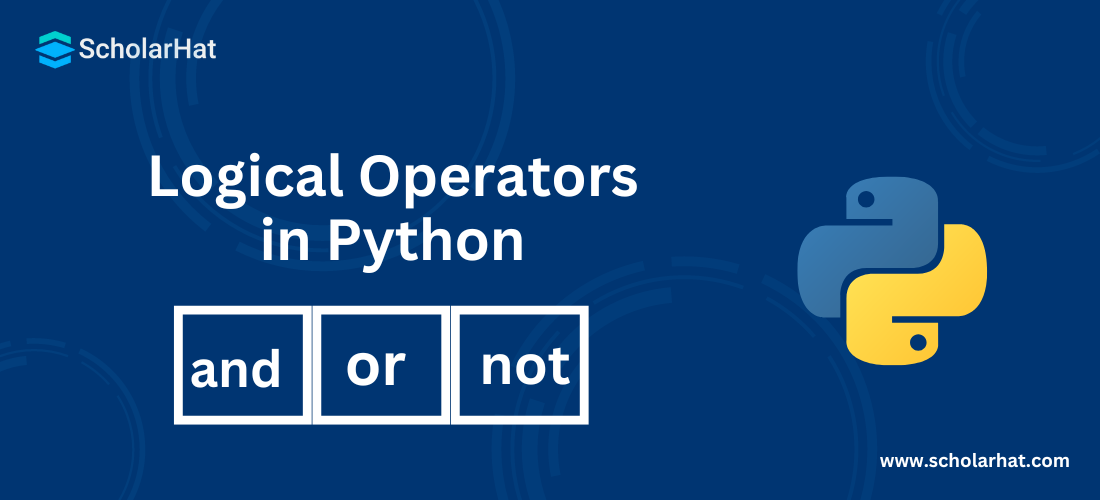18
AprLogical Operators Python
Logical Operators in Python: An Overview
Python, renowned for its simplicity and readability, includes a set of logical operators that play a pivotal role in decision-making within programs. Previously we have seen types of operators in Python. In this article, we will learn about the logical operators in Python, exploring their types and providing examples to illustrate their usage.
If you want more concepts regarding Python and operators, you must explore a Python tutorial, which provides you with each and every concept of Python in detail with hands-on examples. Additionally, enrolling in a Python for Data Scientists with AI course can help you gain advanced knowledge and practical experience to excel in the field.
What are the Logical Operators in Python?
Logical operators allow developers to define complex conditions based on Boolean values, making it easier to write robust and efficient code. Logical operators are symbols or keywords that are used to alter Boolean values and produce a Boolean result. Python has three logical operators: and, or, and not.
These operators enable programmers to combine and modify Boolean values to make decisions.
Syntax
operand_1 logical_operator operand_2Truth Table for Logical Operators in Python
| Operand1 | Operand2 | Operand1 AND Operand2 | Operand1 OR Operand2 | NOT (Operand1) | NOT (Operand2) |
| T | T | T | T | F | F |
| T | F | F | T | F | T |
| F | T | F | T | T | F |
| F | F | F | F | T | T |
Read More - 50 Python Interview Questions
Types of Logical Operators
1. AND Operator
AND operator returns True only if both of its operands are true; otherwise, it returns False. It is often used to check multiple conditions simultaneously.
Syntax
operand_1 and operand_2Example
x = True
y = False
result = x and y
print(result)Explanation
Output
False
2. OR Operator
The OR operator returns True if at least one of its operands is true; otherwise, it returns False. It provides a flexible way to handle situations where multiple conditions may lead to the same outcome.
Syntax
operand_1 or operand_2Example
a = True
b = False
result = a or b
print(result)Explanation
Output
TrueRead More - Python Developer Salary
3. NOT Operator
The not operator is a unary operator that returns the opposite Boolean value of its operand. If the operand is True, not returns False, and vice versa.
Syntax
operand_1 not operand_2Example
z = True
result = not z
print(result)Explanation
In this example, a Boolean variable z is assigned the value True. Subsequently, the not operator is applied to the variable z, resulting in the negation of its Boolean value.
Output
FalseExamples of Logical Operators in Python Compiler
Example 1: Checking Age Eligibility
age = 25
if age >= 18 and age <= 60:
print("You are eligible to vote and work.")
else:
print("You are not eligible to vote or work.")Explanation
The example is a simple eligibility check based on age. The variable age is assigned a value of 25, and the code checks whether the age falls within the range of 18 to 60 (inclusive). This example demonstrates a basic use of logical operators (and) to evaluate multiple conditions for decision-making in a Python program.
Output
You are eligible to vote and work.Example 2: Validating User Input
username = input("Enter your username: ")
password = input("Enter your password: ")
if username == "admin" and password == "admin@123":
print("Login successful.")
else:
print("Invalid username or password.")Explanation
This example captures user input for a username and password. It then checks whether the entered username is "admin" and the password is "admin@123". If both conditions are met, the program prints "Login successful." Otherwise, it prints "Invalid username or password." This example demonstrates a basic use of logical operators (and).
Output
Enter your username: admin
Enter your password: admin@123
Login successful.Example 3: Temperature Check
temperature = 30
if temperature > 30 or temperature < 10:
print("Extreme temperature detected. Take precautions.")
else:
print("Temperature is within the normal range.")Explanation
This Python code snippet in the Python Editor checks the value of the variable temperature to determine if it falls outside the normal temperature range. This code showcases the use of logical operators (or) in a conditional statement to make decisions based on specific temperature conditions.
Output
Temperature is within the normal range.Summary
Logical operators are indispensable tools in Python programming, enabling developers to create intricate decision structures. The and, or, and not operators empower programmers to build flexible and efficient code, enhancing the overall functionality of Python applications.
This was all about the basics of logical operators in Python, if you want to go deeper into data types then consider enrolling in a Python Certification Course.







